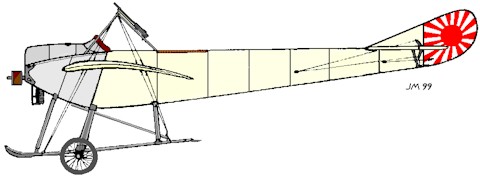Nieuport monoplane Brief history of the Nieuport monoplane The Japanese Army kept a close eye on the rapid development of aircrafts in Europe in the fragile time just before the great war. Several of them were bought, shipped and tested in Japan. Among many types of aircrafts imported were two Nieuport monoplanes in 1913. They were to be used for training, but also became the first airplanes, together with Henry Farman aircrafts, to fly into battle for the Japanese. The two Nieuport monoplanes were imported from France by the Japanese Army in 1913. They were of different types, one being a Nieuport NG two seater and the other a Nieuport NM three seater. Both were built in 1910 and were very similar in appearance. The aircraft was considered pleasant to fly even though it had it's unique characteristics. The Monoplane was not controlled in the "normal" way. The feet pedals were used to work the ailerons instead of the rudder. This was because the whole wing acted as the aileron and the strength in a persons legs and feets were needed to work it. Both the vertical and horizontal rudders were then controlled by the joystick. Many pilots therefore learned to fly the airplane using only the tail surfaces for steering like a simple radio controlled airplane model. The ground handling was difficult as there was no tail wheel. The Nieuport was standing on the wheels and the end of the ski. This made the aircraft very sensitive to wind gusts due to the long tail. The monoplanes could carry one pilot and one (NG) or two (NM) passengers. However, the space behind the pilot was limited and especially for the two seater was it vital that the passenger was light weight.. In 1914, Britain and France went to war against Germany and Austria. Japan who was in alliance with Britain and France attacked German Austrian forces in China. A campaign that lasted from September 4 to November 6 that year and would mark the first use of aircrafts in battle for the Japanese. The Japanese Army had the two Nieuport monoplanes, four Henry Faraman biplanes and eight pilots available to fly reconnaissance sorties over the enemies territory. Soon were also small bombs carried and dropped over the German Austrian positions. The most well known attack during the campaign was the joint Army and Navy attack on the German Austrian fleet at Tsingtao. The main target, a German cruiser, was missed but a small torpedo boat was sunk. The Japanese also encountered a German Rumbler Taube which they tried to bring down. This failed due to the Rumblers superior agility. However, the effect of the first Japanese aircombat was the same as a downing as the German Pilot was forced to land in neutral China and destroy the aircraft to ensure that it would not fall into the wrong hands. In total the Army made 86 sorties with the Nieuports and Henry Farmans and dropped 44 bombs during the campaign. Profile
The profile above shows a one of the Nieuports in China. If the gun was mounted prior of the encounter with the Rumbler or after is not known. But most probaby, it was mounted afterwards in the event they would meet another German airplane. Profile reference The profile is based on a picture in a small and quite old Japanese bocklet which name I have not been able to figure out. Other references on the Nieuport are:
|
